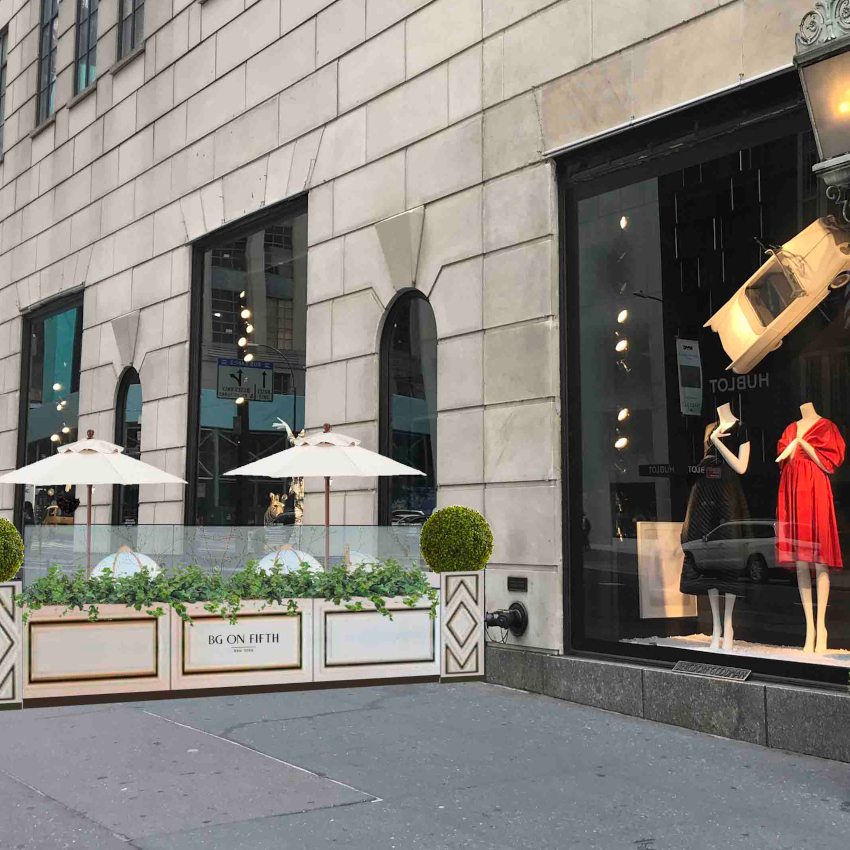Much has been written about the gradual demise of the golden era of department stores. With the growing monopoly of e-commerce and the added catalyst of a pandemic, the future of brick-and-mortar stores looks beyond grim. Much has also been written about the pandemic’s other victim, the restaurant industry, similarly suffering a blow that it may never recover from. But no one is talking about the retailer-eatery union, the long legacy of restaurants nestled inside department stores, a symbiotic relationship that was envisioned as contributing to the shopper’s overall experience. Not only has the pandemic affected in-store shopping and indoor dining, separately, but it has almost completely decimated what was supposed to be an essential and beautifully cohesive marriage between the two.
Tea Rooms Redux
The all-encompassing shopping experience, satisfying the shopper’s desire for service as well as exclusive dining, is a revitalized concept designed to lure customers away from their online shopping carts and into the physical store. And in many ways, it proved successful. Michael Lisicky, an author and historian, specializing in the history of department stores describes the legacy of in-store eateries dating all the way back to the 19th century in London at Harrod’s and in the U.S. when Wanamaker’s Crystal Tea Room was first established. The 20th century saw even more glamorous tea rooms and high-end dining establishments, complete with fashion models showcasing the most current trends, all with the intent of keeping the shopper in the store as long as possible.
Since the golden era of the department store, there has been a slow decline, as retailers struggle to maintain a steady flow of customers through their doors. What better way to entice shoppers back into your store than with fine dining, cocktails and Instagram worthy tea cakes? If you’re indulging in some retail therapy, why not take the time to indulge your taste buds as well? Savvy retailers saw that restaurants could be an essential part of the customer’s shopping experience: Restoration Hardware’s stunning rooftop dining, Ralph Lauren’s The Polo Bar and RL, L’Avenue at Saks Fifth Avenue, Tiffany’s Blue Box Cafe and Nordstrom’s seven upscale cafes in the N.Y. store — just to name a few.
And Then Came the Pandemic
The coronavirus lockdowns across the nation forced both retailers and restaurants alike to shutter their doors as people had to shelter-in-place and the economy halted to a stop. This pause in the normal day-to-day exchanges between sellers and consumers proved devastating to many businesses, large and small. The pandemic exposed gaping financial inequalities and the list of businesses facing closure continues to grow longer and longer.
The question at the forefront of all retail industry discussion seems to be whether this is the end of department stores as we know it or is there a chance they will live to see another day? The layoffs and accumulation of debt many retailers continue to face seem to suggest the former.
For the restaurant industry, the news is equally grim.
The Restaurant Industry Impact Survey, published by the National Restaurant Association, reports the extensive economic impact of the coronavirus on the restaurant industry, surveying more than 6,500 restaurant operators nationwide. They predict that the industry will sustain $240 billion in losses by the end of 2020. This, of course, includes the restaurants inside department stores and shopping malls across the nation.
For those of us in New York, Governor Andrew M. Cuomo announced indoor dining in New York City would be allowed to resume beginning September 30th with a 25 percent occupancy limit. But the big gamble is whether New Yorkers will actually venture back indoors for dining. For many, employees and customers alike, there remains a substantial amount of uncertainty and anxiety surrounding the onset of indoor dining, just as there was when retail stores were allowed to open at reduced capacity. So, what does this mean for the business models that relied on the seamless experience of shopping and dining under the same roof?
Bergdorf Goodman’s BG
An icon in the retail-eatery business, Bergdorf Goodman’s BG Restaurant, on the 7th floor of the department store with stunning views of Central Park and beautifully embellished decor, has opened a greenery-enclosed café on Fifth Avenue between 57th and 58th streets. Darcy Penick, president of Bergdorf Goodman, offered insights on the continuation of restaurant service amidst COVID restrictions, “At Bergdorf Goodman, we have always been committed to delivering an unparalleled luxury service to our clients, and BG Restaurant has always played an integral role in that experience. We’re thrilled to be able to offer the same level of service and cuisine in this distinctive outdoor setting along Fifth Avenue.” The BG Restaurant will also be open for indoor service starting at 25 percent capacity with limited reservations and strict CDC-approved safety protocols.
Logistically speaking, many department stores have struggled to open outdoor seating for their in-store restaurants due to the mere fact that many are situated above ground level. Bergdorf Goodman has managed to create an outdoor oasis that, despite not offering sweeping views of the park from above, still feels somewhat elevated in its refined atmosphere and same high-quality service and cuisine.
This is the closest any department store has come to offering some semblance of elegant “in-store” (but still outdoor) dining and as the colder months set in, it will be interesting to see how they fare.
Macy’s Stella Trattoria & Bar
Stella 34 Trattoria is a modern Italian restaurant located inside Macy’s in Midtown NYC offering views of the Empire State Building and mouthwatering Italian dishes. It is one of the best things on 34th and a valiant attempt to draw shoppers back through their doors. The restaurant temporarily closed due to COVID, relying on business solely from delivery and pick up. On Oct 15 they opened again for indoor dining at 25 percent capacity.
L’Avenue at Saks
L’Avenue at Saks, the trendy New York outpost of the original L’Avenue in Paris, is a stunningly impressive example of just how the retailer-restaurant relationship could succeed. It was an escape from the hustle and bustle of shoppers on Fifth Avenue and an exquisite taste of Paris. The “sceney” spot hosted numerous A-list celebrity events and established itself as a destination not only for delectable French dining, but a place where you can go to see and be seen.
But L’Avenue’s renown and notability did little to protect the restaurant from the clutches of the pandemic and subsequent closing of restaurant and retail doors. For the past few months the restaurant has been relying on takeout and meal kits and just recently was able to open its doors once again for indoor dining at 25 percent capacity. But with the implementation of new services at Saks Fifth Avenue, where shoppers can take virtual shopping trips through the store with the assistance of a store associate via video conferencing, I can’t imagine very many people will be venturing into the store, much less dining.
Dining-In Casualties
Across the nation, in-store restaurants suffer similar losses. Macy’s quietly closed its Lakeshore Grill restaurants at Southdale and Ridgedale, Minnesota, in August. Neiman Marcus’s NM Cafes from New York City to Dallas, TX as well as The Zodiac Room in Hudson Yards, NY have all been temporarily closed, and who knows if they will ever reopen.
Is this the end of department stores as we know it or is there a chance they will live to see another day? The layoffs and accumulation of debt many retailers continue to face seem to suggest the former.
The traditional department store may be nearing its end, and the impossibility of indoor dining at full capacity, which was supposed to provide the shopper with an unrivaled luxurious experience, just may be the final nail in the coffin.
Footnote: Ladies Who Lunch
It would be an oversight when talking about the golden era of the department store — from its birth to its present-day demise — without alluding to the Ladies Who Lunch. This outdated, yet glamorously iconic trope from a time in history when shopping was more than just a quick trip to and from the store, was a luxurious experience, enjoyed in all its splendor. Chalk it up to another casualty of the pandemic. Today’s woman of the “Coronavirus Era” is anything but an overqualified idler. So, this may be just one more reason why retailers need to insert themselves relevantly in the busy and overextended lives of women who not only not lunch, but work, socialize, and provide for their families.





